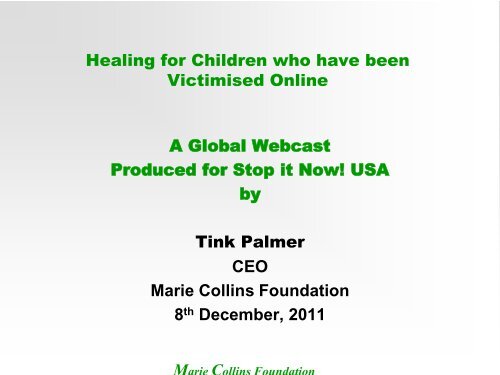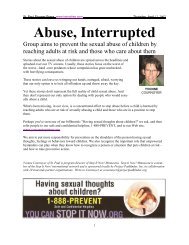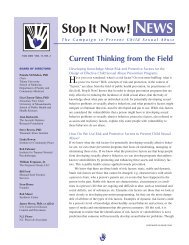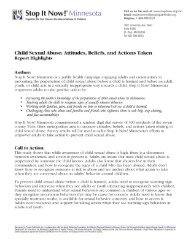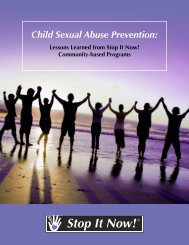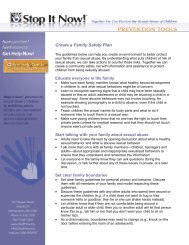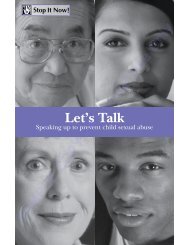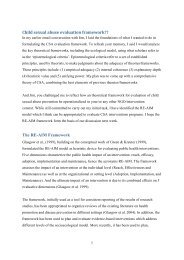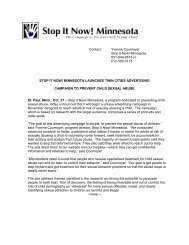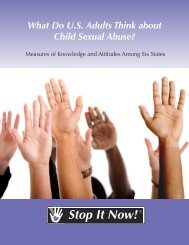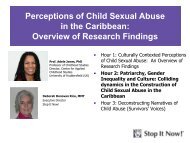Marie Collins Foundation - Stop It Now
Marie Collins Foundation - Stop It Now
Marie Collins Foundation - Stop It Now
Create successful ePaper yourself
Turn your PDF publications into a flip-book with our unique Google optimized e-Paper software.
Healing for Children who have been<br />
Victimised Online<br />
A Global Webcast<br />
Produced for <strong>Stop</strong> it <strong>Now</strong>! USA<br />
by<br />
Tink Palmer<br />
CEO<br />
<strong>Marie</strong> <strong>Collins</strong> <strong>Foundation</strong><br />
8 th December, 2011
The aims of today’s presentation<br />
• To enable participants<br />
• to consider the nature of the impact of online<br />
initiated abuse on victims and their families<br />
• To reconsider current practice in the light of the<br />
identified need for change in relation to children<br />
and young people abused via the internet and<br />
mobile technologies<br />
<strong>Marie</strong> <strong>Collins</strong> <strong>Foundation</strong>
Central messages!<br />
• We are all on a steep learning curve<br />
• We have some answers – but not very many<br />
• Use this time to think imaginatively about how we<br />
might do things differently<br />
• Your thinking may well help influence good practice<br />
for the future<br />
• Think “out of the box”!<br />
<strong>Marie</strong> <strong>Collins</strong> <strong>Foundation</strong>
Webcast Rules!<br />
1. Show respect<br />
2. Take responsibility seriously<br />
3. Work hard – always do your best<br />
4. Treat everyone fairly<br />
Source: Kell bank primary school<br />
<strong>Marie</strong> <strong>Collins</strong> <strong>Foundation</strong>
The <strong>Marie</strong> <strong>Collins</strong> <strong>Foundation</strong><br />
A credo<br />
• “Every experience in life, everything with which we<br />
have come into contact in life, is a chisel which has<br />
been cutting away at our life statue, moulding,<br />
modifying, shaping it. We are part of all we have met.<br />
Everything we have seen, heard, felt, or thought has<br />
had its hand in moulding us, shaping us”<br />
American author Orison Swett Marden (1850-1924)<br />
<strong>Marie</strong> <strong>Collins</strong> <strong>Foundation</strong>
The <strong>Marie</strong> <strong>Collins</strong> <strong>Foundation</strong>’s<br />
six point plan<br />
• Work in partnership with other agencies, both within<br />
the UK and internationally, to raise awareness<br />
regarding the abuse of children and young people via<br />
the internet and mobile technologies.<br />
• Offer services to children, young people and their<br />
families affected in this way.<br />
• Provide training for professionals who work with<br />
children and young people – social workers,<br />
teachers, health professionals and police.<br />
<strong>Marie</strong> <strong>Collins</strong> <strong>Foundation</strong>
The <strong>Marie</strong> <strong>Collins</strong> <strong>Foundation</strong>’s<br />
six point plan continued<br />
• Offer consultancy to professionals assisting children<br />
and young people in their recovery from harms they<br />
have experienced via the new technologies.<br />
• Lobby and influence governments and international<br />
stakeholders to better protect children and young<br />
people when online and to provide appropriate<br />
responses to their recovery needs when harmed.<br />
• Engage the media in responsible and informed<br />
debate regarding the impact of abuse on children and<br />
young people when harmed via the internet and<br />
mobile technologies.<br />
<strong>Marie</strong> <strong>Collins</strong> <strong>Foundation</strong>
Mary Kozakiewicz and her daughter Alicia<br />
• “The internet is possibly the greatest social<br />
experiment of all time but one in which children can<br />
be the sacrificial guinea pigs. I use the analogy of a<br />
loaded gun. No one warned us about it yet they<br />
blamed us when the kids started to shoot<br />
themselves”<br />
<strong>Marie</strong> <strong>Collins</strong> <strong>Foundation</strong>
Background and context<br />
• “<strong>It</strong>’s not so much what was done to me but what it did<br />
to my head”<br />
<strong>Marie</strong> <strong>Collins</strong><br />
<strong>Marie</strong> <strong>Collins</strong> <strong>Foundation</strong>
WCIII, 2008- changes since WCII, 2001<br />
• Increase in countries developing definitions and laws<br />
related to abuse through the new technologies<br />
• Advance in the capacity of law enforcement to<br />
respond nationally and internationally<br />
• An acknowledgement that the problems require a<br />
multi-agency and multi-sector approach<br />
• Increased education, particularly of children, and<br />
inclusive of children<br />
<strong>Marie</strong> <strong>Collins</strong> <strong>Foundation</strong>
Unresolved challenges?<br />
• Lack of critical understanding of the harms posed by<br />
the new technologies<br />
• Lack of training, expertise and capacity to investigate<br />
such crimes against children, to protect them from<br />
harm and assist in their recovery.<br />
<strong>Marie</strong> <strong>Collins</strong> <strong>Foundation</strong>
UNICEF - Sexual abuse and exploitation in the<br />
converged online/offline environments: referral<br />
services and rehabilitation -11 recommendations<br />
• An international Forum for professionals working with<br />
victims of online abuse should be established to enable<br />
shared learning resulting in informed practice<br />
• Current ways of interviewing child victims of internet<br />
related crimes for evidential purposes need reviewing and<br />
good practice models developed<br />
• Good practice models need to be developed for<br />
assessment and intervention programmes for children<br />
abused online<br />
<strong>Marie</strong> <strong>Collins</strong> <strong>Foundation</strong>
Recommendations<br />
• Strategies, procedures and intervention models for young<br />
people with sexually problematic and harmful behaviours<br />
online need developing within a child development context<br />
and one that recognises the dual requirement to address<br />
both the protection needs and the criminal justice issues<br />
posed by the young person’s behaviour<br />
• Training programmes regarding the impact of online<br />
abusive behaviours on children and their families ,and their<br />
recovery needs, should be developed for professionals<br />
working with traumatised children<br />
<strong>Marie</strong> <strong>Collins</strong> <strong>Foundation</strong>
Child sexual abuse per se<br />
• What hasn’t changed: some static statistics<br />
• Most adult survivors didn’t disclose as children and<br />
don’t disclose as adults - silencing of children<br />
• 1 in 6 children are victims of sexual abuse (Cawson et<br />
al)<br />
• 8 out of 10 abusers are known to the child<br />
• Over 90% of allegations do not result in convictions<br />
• Less than 10% of child sexual abuse is dealt with by the<br />
criminal courts. Most is not reported to the authorities.<br />
• Incidence v prevalence – any differences regarding the<br />
internet and mobile technologies?<br />
<strong>Marie</strong> <strong>Collins</strong> <strong>Foundation</strong>
Gridlock<br />
Parent/carer<br />
Abused child<br />
Abuser<br />
<strong>Marie</strong> <strong>Collins</strong> <strong>Foundation</strong>
For Disclosure We Need:<br />
• A culture that will hear children<br />
• A legal framework that will:<br />
- offer protection to the child<br />
- actively pursue the alleged perpetrator<br />
through the criminal justice system<br />
- reflect the differential needs of child<br />
witnesses<br />
• A systemic approach that is child focused - ABE<br />
<strong>Marie</strong> <strong>Collins</strong> <strong>Foundation</strong>
In The Aftermath of Disclosure the Child<br />
Needs:<br />
• To feel believed<br />
• To be in a safe place<br />
• To be protected from contact with the perpetrator<br />
• To be offered therapy<br />
• To be supported through the process of ‘being a<br />
witness’<br />
• Never underestimate the impact of disclosure on<br />
the child<br />
<strong>Marie</strong> <strong>Collins</strong> <strong>Foundation</strong>
The uniqueness of each child’s experience<br />
• The degree of internalisation of sexually abusive<br />
experiences is unique to each child and<br />
dependent on factors such as<br />
• The nature of the abuse<br />
• The circumstances in which it occurred<br />
• The modus operandi of the abuser<br />
• The nature of the child’s previous life<br />
experiences<br />
• To whom the child disclosed, how many<br />
attempts?<br />
• The degree of support within the family<br />
• The child’s natural “in-built” resilience<br />
<strong>Marie</strong> <strong>Collins</strong> <strong>Foundation</strong>
A working model<br />
• The child’s protective carer needs:<br />
• Support in coming to terms with their child’s disclosure<br />
• Education<br />
o Regarding the MO of offenders<br />
o Regarding the impact of sexual abuse on the child<br />
and the possible resultant behaviours<br />
o Regarding the impact of the MO of the abuser on the<br />
carer and other family members<br />
• Personal support due to the possibility of issues from<br />
their own past being re-stimulated<br />
<strong>Marie</strong> <strong>Collins</strong> <strong>Foundation</strong>
A working model<br />
• Therapeutic intervention<br />
• Purpose – help make the child victim make sense of<br />
what has happened<br />
• Value of Early Therapeutic Intervention<br />
• Impacts on the child if the issues are not addressed<br />
• Trauma of disclosure<br />
• Impacts on the child of the time-lag between disclosure<br />
and therapeutic intervention<br />
• Pre-trial therapy<br />
<strong>Marie</strong> <strong>Collins</strong> <strong>Foundation</strong>
A working model<br />
• Therapeutic intervention<br />
• Key treatment focus – interconnection between how the<br />
child feels, thinks and behaves<br />
• Treatment programme draws on cognitive and<br />
behavioural therapy but takes a more holistic approach<br />
<strong>Marie</strong> <strong>Collins</strong> <strong>Foundation</strong>
A working model<br />
• The therapeutic context will involve addressing:<br />
• The impact issues<br />
• The resultant behavioural issues<br />
• The resultant emotional issues<br />
<strong>Marie</strong> <strong>Collins</strong> <strong>Foundation</strong>
A working model<br />
• Impact issues<br />
• Damaged good syndrome<br />
• Guilt<br />
• Fear<br />
• Depression<br />
• Low self esteem and poor social skills<br />
• Repressed anger and hostility<br />
• Inability to trust<br />
• Blurred role boundaries and role confusion<br />
• Pseudo-maturity and failure to complete developmental tasks<br />
• Lack of self mastery and control<br />
• Cognitive confusion<br />
• grief<br />
<strong>Marie</strong> <strong>Collins</strong> <strong>Foundation</strong>
A working model<br />
• Resultant behavioural issues<br />
• Acting aggressively<br />
• Breaking the rules/law<br />
• Compulsive masturbation/sexual acting out<br />
• Eating disorders<br />
• Depression<br />
• Fire setting<br />
• Running away<br />
• Attempts at self harm/suicide<br />
• Withdrawn/isolated<br />
• Development of chronic physical illness<br />
• Unfeeling/denying feelings<br />
• Use of drugs, solvents, alcohol to block feelings<br />
• Lack of self respect, self confidence and self esteem<br />
• Flashbacks<br />
• Intense mood changes<br />
• Lack of memories of all or parts of life<br />
• Difficulties in forming appropriate relationships either with adults when a child or as an adult<br />
• Lack of trust in others<br />
<strong>Marie</strong> <strong>Collins</strong> <strong>Foundation</strong>
A working model<br />
• The therapeutic process includes work with the<br />
child on<br />
• Their perception of safety<br />
• Expression and ventilation of feelings<br />
• Empowerment<br />
• Sex education<br />
• Education about sexual offending<br />
• Guilt, trust and ambivalence<br />
• Assertiveness and communication skills<br />
• Wishes and fears for the future<br />
<strong>Marie</strong> <strong>Collins</strong> <strong>Foundation</strong>
A working model<br />
• Activities<br />
• Painting, role play, drawing, play dough, water play<br />
• Play people, art therapy, drama, clay work, sand play,<br />
• Symbolic representation, growing plants, sewing<br />
• Pattern making, cooking, bibliography, music, quizzes<br />
• Ball pool, board games, ball games, card games<br />
• Table tennis, writing, construction toys, puppets,<br />
• Model making, mask making<br />
<strong>Marie</strong> <strong>Collins</strong> <strong>Foundation</strong>
A working model<br />
• Process<br />
• Criteria for referral<br />
• Documents<br />
• Pre-planning meeting<br />
• Planning meeting<br />
• Assessment meeting<br />
• Review meetings<br />
• Final review meeting<br />
<strong>Marie</strong> <strong>Collins</strong> <strong>Foundation</strong>
A working model<br />
• Safe practice<br />
• Staffing /recruitment<br />
• Supervision – internal and external<br />
• Recording – content, accuracy and promptness<br />
• Quality control – files checked<br />
<strong>Marie</strong> <strong>Collins</strong> <strong>Foundation</strong>
Abuse via the internet and mobile<br />
technologies<br />
• Don’t throw the baby out with the bath water!<br />
• Knowledge<br />
• Practice skills and experience<br />
• Identify differences in behaviours and impacts<br />
• Identify differential practice approaches to better<br />
assist child victims<br />
<strong>Marie</strong> <strong>Collins</strong> <strong>Foundation</strong>
Features of the new technology which<br />
facilitate the sexual abuse of children<br />
2003 - 2010<br />
• Easily accessible<br />
• Hidden activity<br />
• Eases communication – both on a national and<br />
international level<br />
• <strong>It</strong>’s quick<br />
• Acts as a conduit between ATP – Trafficking – Abuse online<br />
• Joined up thinking<br />
• 2010<br />
• Growth, sexualisation of children (Popadopolous review),<br />
children’s views of online/offline, divide between<br />
children and adults re: knowledge and workings of New<br />
technology<br />
<strong>Marie</strong> <strong>Collins</strong> <strong>Foundation</strong>
What about the victims and their families?<br />
• No cohesive, uniform approach to<br />
• Identification<br />
• Investigation<br />
• Assessment<br />
• Interventions<br />
• Parent/carer support<br />
<strong>Marie</strong> <strong>Collins</strong> <strong>Foundation</strong>
Referrals<br />
• Children viewing adult pornography<br />
• Children abused through prostitution and/or<br />
trafficking – abusers use the Internet and mobile<br />
phones to control their victims<br />
• Children made the subjects of abusive images<br />
• Children groomed online and abused offline<br />
and/or online<br />
• Children made the subjects of abusive images,<br />
groomed online and abused online and or offline<br />
<strong>Marie</strong> <strong>Collins</strong> <strong>Foundation</strong>
Referrals<br />
• Young people displaying sexually harmful<br />
behaviours online<br />
• Young people presenting as gay, lesbian or bisexual<br />
online who are groomed online and<br />
sexually abused offline<br />
• Children living in a household where a family<br />
member has been apprehended for viewing child<br />
abuse images<br />
<strong>Marie</strong> <strong>Collins</strong> <strong>Foundation</strong>
Children groomed online for sexual abuse<br />
online and/or offline<br />
• HOW DO GROOMERS GROOM ONLINE?<br />
• Scenario 1<br />
• Find out as much as they can about their potential victim<br />
• Establish the risk and likelihood of child telling<br />
• Find out about child’s family and social networks<br />
• If “safe enough” will isolate their victim – may use flattery and<br />
promises or threats and blackmail – and get control<br />
• Give false information, including false self images<br />
• Scenario 2<br />
• May need to do very little of the above – how does this<br />
make us feel?<br />
<strong>Marie</strong> <strong>Collins</strong> <strong>Foundation</strong>
Finkelhor – ‘A clinical application’<br />
Adapted from:- D Finkelhor Child Sexual Abuse: New Theory & Research 1986<br />
Sex with<br />
a child<br />
Thoughts<br />
MOTIVATION<br />
‘Wanting to’<br />
INTERNAL<br />
INHIBITORS<br />
‘Conscience’<br />
EXTERNAL<br />
INHIBITORS<br />
‘Creating<br />
Opportunity’<br />
OVERCOME<br />
VICTIM RESISTANCE<br />
‘Doing it and getting<br />
away with it’
Children groomed online for sexual abuse<br />
online and/or offline<br />
• CASE EXAMPLES<br />
• Young person groomed online and sexually<br />
abused offline<br />
• Young person groomed online<br />
• Common denominators – saw the abuser as “so<br />
normal”, neither would have told anyone,<br />
shame/anger when approached by police<br />
<strong>Marie</strong> <strong>Collins</strong> <strong>Foundation</strong>
Children groomed online for sexual abuse<br />
online and/or offline<br />
• IMPACT<br />
• Silencing of the children<br />
• WHY?<br />
• Children’s behaviour on the net is less<br />
inhibited - they will say things that they<br />
wouldn’t in the real world and are fearful of<br />
those close to them finding out about what<br />
they have said<br />
• Children are conscious of peer opinion – they<br />
wouldn’t want them to know that they have<br />
been “duped”<br />
<strong>Marie</strong> <strong>Collins</strong> <strong>Foundation</strong>
Quotes from children<br />
• “I would never have told anyone if the police<br />
hadn’t come knocking at our door. <strong>It</strong> turned out<br />
that they had arrested the bloke I was friends with<br />
online and had traced me through examining his<br />
computer. First off, I said they’d got the wrong<br />
person….I was terrified my mum and dad would<br />
know what I had been talking about….you don’t<br />
even talk to your friends about what you say<br />
online….somehow it seems a different<br />
world….one in which I can act like I’m 22 when<br />
I’m actually only 14”<br />
<strong>Marie</strong> <strong>Collins</strong> <strong>Foundation</strong>
Vulnerability?<br />
• None of the young women could be perceived as<br />
vulnerable in their offline world and would not fit<br />
into the four categories that we might class as<br />
vulnerable offline - children who experience family<br />
difficulties/chaotic home environments, children with disabilities, children<br />
with emotional/behavioural difficulties and children who experience<br />
“exclusion of access”<br />
• They were remarkable for their heterogeneity -<br />
personalities, economic status, family backgrounds etc.<br />
• What is of note is their homogeneity in respect of<br />
the impacts of the abuse on their thinking, feeling<br />
and behaviour post trauma<br />
<strong>Marie</strong> <strong>Collins</strong> <strong>Foundation</strong>
What’s different online?<br />
A young person’s perspective<br />
• “The internet is a weird version of the real world where you can<br />
do everything<br />
• Groomers don’t have to worry about seeming suspicious<br />
• Children can act like adults<br />
• I used people online to make me feel good<br />
• Girls use groomers to make them feel mature – groomers use girls<br />
for sex – it’s mutual using of one another<br />
• Girls get involved with men because nothing much seems to be<br />
happening when you’re 12-14 but you want to be older<br />
• The most talkative (girls) online are the quietest offline<br />
• The most normal (man) online is a real weirdo offline<br />
• We rarely talk about our behaviour online – kind of embarrassing”<br />
<strong>Marie</strong> <strong>Collins</strong> <strong>Foundation</strong>
What works for recovery?<br />
• Contextualise therapeutic interventions within the<br />
young person’s transitional stage of development<br />
• Understand the conflicting dynamic for the young<br />
person of being like an adult online but a<br />
child/young person offline<br />
• Give time and space<br />
• Use narrative about known activities online –<br />
giving permissions<br />
• Acknowledge what we know regarding how they<br />
must be feeling - shame, fear, anger, impotence,<br />
silence, love, betrayal, guilt…….<br />
<strong>Marie</strong> <strong>Collins</strong> <strong>Foundation</strong>
What works for recovery?<br />
• Safeguarding measures need to change –<br />
• Investigation<br />
• Assessment<br />
• Interventions<br />
• Support for parents<br />
• The way we deliver prevention messages to this particular<br />
age group of young people<br />
<strong>Marie</strong> <strong>Collins</strong> <strong>Foundation</strong>
Children made the subjects of child abuse images<br />
• History – availability, old images, introduction of the digital<br />
camera<br />
• COPINE – monitored the online behaviour of sexual<br />
abusers within Newsgroups<br />
• Between 1999 – 2002 average of 4 new children a month<br />
were appearing in child sex newsgroups; in 2002 – number<br />
had risen to 12, in 2003 a huge increase in new images<br />
occurred<br />
• IWF findings<br />
• Nature of the images<br />
• Research by Quayle and Jones 2009<br />
• This is sexual abuse<br />
<strong>Marie</strong> <strong>Collins</strong> <strong>Foundation</strong>
NSPCC sample – April, 2010<br />
• Method – analysed media reports of court cases<br />
over the past 20 months<br />
• 2 million+ images circulated by 100 offenders<br />
who were consequently convicted<br />
• 50,000 of the images were category 5<br />
• 1 in 4 offenders had held positions of trust –<br />
including teachers, clergymen, medics and police<br />
<strong>Marie</strong> <strong>Collins</strong> <strong>Foundation</strong>
Demographics re: sexualised images of<br />
children on the internet<br />
• Quayle and Jones<br />
• Sample – Childbase (hosted by CEOP) – Holding<br />
over 800,000 unique still images collected since<br />
1998<br />
• Images for period April 2005-2009 (240,000) were<br />
sampled – 10% (24,000) selected for more<br />
detailed examination<br />
• Images sorted into three categories – gender, age<br />
(pubescent, pre-pubescent and very young) and<br />
ethnic group<br />
<strong>Marie</strong> <strong>Collins</strong> <strong>Foundation</strong>
Demographics re: sexualised images of<br />
children on the internet<br />
• Gender – female children were 18 times more<br />
likely than male children to be in the images<br />
• Ethnicity – white children were 96 times more<br />
likely than none white to be found in the images<br />
• Age – male children depicted in the images were<br />
more likely to be pre-pubescent and very young<br />
• Caveat re: boys and numbers!<br />
<strong>Marie</strong> <strong>Collins</strong> <strong>Foundation</strong>
The impact on child victims when images of<br />
their abuse are placed on the internet<br />
• Very little research to date<br />
• Burgess et al. 1984 – Pornography and sex rings<br />
• Silbert 1989 – Pornography and Child Protection<br />
• Svedin and Back, 1996, Pornography and Intra-Extra<br />
Famial abuse<br />
• Scott, 2001, Pornography and Ritual Abuse<br />
• Palmer, 2005<br />
• Svedin and Back, 2006<br />
• Solderstrom, 2006<br />
• Future findings<br />
<strong>Marie</strong> <strong>Collins</strong> <strong>Foundation</strong>
Children made the subjects of child abuse images<br />
• Abusers may show children abusive images of<br />
children to normalise the activity<br />
• Children may be made to view their own abuse<br />
images<br />
• Children may be encouraged to introduce their<br />
friends or other children within their family to the<br />
abuser<br />
<strong>Marie</strong> <strong>Collins</strong> <strong>Foundation</strong>
Children made the subjects of child abuse images<br />
• Children may be encouraged to be proactive in<br />
the sexually abusive scenario – either with the<br />
perpetrator or with other children<br />
• Children may be encouraged to place<br />
photographs/images of themselves online<br />
<strong>Marie</strong> <strong>Collins</strong> <strong>Foundation</strong>
From discovery to disclosure<br />
implications for practice<br />
• Discovery - never under-estimate the impact on<br />
the victim – double impact – why?<br />
• Identification<br />
• Disclosure - never under-estimate the impact on<br />
the victim<br />
• Investigation<br />
• Assessment<br />
• Therapeutic intervention<br />
• Witness experience<br />
<strong>Marie</strong> <strong>Collins</strong> <strong>Foundation</strong>
Discovery<br />
• Proof of abuse<br />
• Proof of activity<br />
• Proof of distress<br />
• What are we doing about it?<br />
• Identification?<br />
<strong>Marie</strong> <strong>Collins</strong> <strong>Foundation</strong>
Actively seeking child victims<br />
• Should we leave well alone?<br />
• Hidden nature of sexual abuse<br />
• Lasting impacts<br />
• Children are not going to tell us<br />
• We must go out and seek them<br />
<strong>Marie</strong> <strong>Collins</strong> <strong>Foundation</strong>
Disclosure by discovery<br />
• No control of the process of disclosure<br />
• The “secret” between victim and perpetrator<br />
becomes the most open secret<br />
• The victim may not have known the images had<br />
been taken<br />
<strong>Marie</strong> <strong>Collins</strong> <strong>Foundation</strong>
Disclosure/Investigation<br />
• Initial contact with the family<br />
• Cold calling<br />
• Lack of information<br />
• Support for parents<br />
• Role of the social worker<br />
• Role of the school<br />
<strong>Marie</strong> <strong>Collins</strong> <strong>Foundation</strong>
Disclosure/Investigation<br />
• Police and social worker have access to exactly<br />
what has happened to the child via the abusive<br />
images<br />
• This differs significantly from any other form of<br />
police/social worker interviews of child victim<br />
• Children limit disclosure – telling people only<br />
what they think they know<br />
• The child is often so silenced that he/she cannot<br />
admit what has happened even when confronted<br />
with the evidence<br />
<strong>Marie</strong> <strong>Collins</strong> <strong>Foundation</strong>
Investigation<br />
• Is it always necessary to interview the child for<br />
evidential purposes?<br />
• In what circumstances might it not be necessary?<br />
• Number of interviews<br />
• Third party approach<br />
• Use of audio/video equipment<br />
• Others in the household<br />
<strong>Marie</strong> <strong>Collins</strong> <strong>Foundation</strong>
New recovery issues<br />
• Impotence regarding disclosure<br />
• Shame<br />
• Responsibility<br />
• Non-resolution – (coming to terms with it) – how<br />
could we address this with the victim?<br />
<strong>Marie</strong> <strong>Collins</strong> <strong>Foundation</strong>
Support for carers<br />
Issues – these apply to various sexually abusive<br />
scenarios of which their child has been the victim<br />
• Fear<br />
• Shock and disbelief that this happened to<br />
their daughter/son<br />
• Anger towards their daughter/son<br />
<strong>Marie</strong> <strong>Collins</strong> <strong>Foundation</strong>
Support for carers - continued<br />
• How their daughter/son got involved in all this,<br />
under their very noses, and they picked up<br />
nothing<br />
• Guilt – what have I (we) done wrong<br />
• Acknowledging that their daughter/son is<br />
interested in sex and a sexual being<br />
• How to engage in conversation about their<br />
daughter’s/sons abuse with one another and<br />
with their child<br />
• Training on safe use of the internet<br />
• Information – knowledge empowers<br />
<strong>Marie</strong> <strong>Collins</strong> <strong>Foundation</strong>
Expressed concerns by parents<br />
• Fear of further cases coming to light connected to their<br />
daughter<br />
• A volatile mixture of anger and blame toward their<br />
daughter/son mixed with a feeling of impotence – they<br />
didn’t know how to keep her/him safe online and didn’t<br />
know what she/he was doing offline<br />
• Incredulity – that their daughter/son engaged in such<br />
behaviour both on and offline when they thought they<br />
were such a close family network<br />
• Not sharing their predicament with friends, colleagues<br />
or other family members – a need to protect their<br />
daughter/son from others knowing what had happened<br />
• They didn’t protect their daughter/son – guilt<br />
<strong>Marie</strong> <strong>Collins</strong> <strong>Foundation</strong>
A local, regional, national and international issue<br />
• Implications for preventative strategies<br />
• Implications for safeguarding and policing<br />
• Implications for recovery and treatment<br />
programmes<br />
<strong>Marie</strong> <strong>Collins</strong> <strong>Foundation</strong>
Children accessing adult pornography<br />
• Ease of accessing the material<br />
• Quantities<br />
• Impacts on children and their views on<br />
relationships<br />
• Beginning of a spiral?<br />
<strong>Marie</strong> <strong>Collins</strong> <strong>Foundation</strong>
Children accessing adult pornography cont…<br />
• Permissions given?<br />
• Desensitisation by adults living in the home<br />
• Grooming by adults outside the home via chatrooms<br />
• Aims of such grooming – desensitisation – feed<br />
groomer’s fantasises<br />
• Demonstration of preferred/fantasised sexual<br />
activity to the child<br />
• Case study – young married man<br />
<strong>Marie</strong> <strong>Collins</strong> <strong>Foundation</strong>
Neuroplasticity<br />
• Neuron – the nerve cells in our brains and<br />
nervous systems<br />
• Plastic – changeable, malleable, modifiable<br />
• 1960s and ‘70s - Scientists from around the world<br />
discovered that the brain was not “hardwired” but<br />
could change its own structure and function<br />
through thought and activity<br />
<strong>Marie</strong> <strong>Collins</strong> <strong>Foundation</strong>
Neuroplasticity<br />
• The Brain that Changes <strong>It</strong>self – Norman Doidge -<br />
Penguin<br />
• Sexual and romantic plasticity – Freud – critical<br />
periods for sexual plasticity –<br />
• Critical periods are brief windows of time when<br />
new brain systems and maps develop with the<br />
help of stimulation from the people in one’s<br />
environment<br />
• Puberty being one of them<br />
<strong>Marie</strong> <strong>Collins</strong> <strong>Foundation</strong>
Neuroplasticity – implications for young<br />
people<br />
• The growth of pornography has been such that it<br />
accounts for<br />
• 25% of video rentals and<br />
• Is the fourth most common reason people give<br />
for going online<br />
<strong>Marie</strong> <strong>Collins</strong> <strong>Foundation</strong>
Young people’s risky and/or harmful<br />
behaviours online<br />
• Concerning behaviour or just experimenting?<br />
• Placing themselves and others at risk – problems<br />
with labelling their behaviour, lack of understanding of<br />
developmental issues – brain development, emotional<br />
development, what do love and control look like, feel like and<br />
sound like? (Sharon Cooper). Needs supersede rules for young<br />
people<br />
• Harmful behaviours<br />
• Downloading abusive images of children*<br />
• Placing images of people online<br />
• Sexual solicitation<br />
• Sexting<br />
• Bullying<br />
<strong>Marie</strong> <strong>Collins</strong> <strong>Foundation</strong>
Children who download sexually abusive<br />
images of children<br />
• Numbers<br />
• Barnardo’s study.<br />
• Wilson and Andrews (2004) and Carr (2004) –<br />
• Looking at sexually abusive practices of Adults and YP<br />
involving abusive images – largest single group of<br />
offenders = 15 – 19 year olds.<br />
• Case study<br />
<strong>Marie</strong> <strong>Collins</strong> <strong>Foundation</strong>
Children who download sexually abusive<br />
images of children<br />
• Assessment and intervention programmes –<br />
protection versus conviction<br />
• Current practice with young people who sexually<br />
harm - some detail<br />
• What needs to be different?<br />
• What about timing regarding disposal of the<br />
matter?<br />
• What questions do we need to ask?<br />
<strong>Marie</strong> <strong>Collins</strong> <strong>Foundation</strong>
ISSUES REGARDING YOUNG PEOPLE DISPLAYING SEXUALLY<br />
HARMFUL BEHAVIOURS<br />
• The need for greater consistency in the application of the<br />
law – both civil and criminal<br />
• The need to dovetail systems of child welfare and youth<br />
crime more effectively<br />
• Concern about children and young people who have<br />
sexually abused being caught up, inappropriately, in the<br />
provisions of the current legislation on sexual offending<br />
• Variability about the way in which young people with<br />
sexually abusive behaviours are managed locally<br />
• The lack of available assessment and treatment services for<br />
young people<br />
• A lack of appropriate alternative care for children and<br />
young people who have been identified as having sexually<br />
abused others<br />
<strong>Marie</strong> <strong>Collins</strong> <strong>Foundation</strong>
Intervention with children and young people needs to be…<br />
• Holistic: focusing on the children’s needs across<br />
all dimensions of their lives and development<br />
• Systemic: involving family, parents and/or carers<br />
in order to improve children’s social<br />
environments and attachment relationships<br />
• Goal specific: designed to address specific<br />
issues relating to the child’s sexually harmful<br />
behaviour<br />
<strong>Marie</strong> <strong>Collins</strong> <strong>Foundation</strong>
Children who download sexually abusive<br />
images of children<br />
• Questions to ask<br />
• How was the behaviour discovered/disclosed?<br />
• In what context did it occur?<br />
• What motivated the child to look at abusive images?<br />
• Was this a planned and calculated activity?<br />
• How long has this activity been going on?<br />
• Was this a sole activity or were others involved?<br />
• What did the carers know about this activity? What is their<br />
reaction to their child’s behaviour?<br />
• Are there child protection issues for the YP and children in the<br />
family?<br />
• What is the nature of the abusive images?<br />
• Criminal justice, child protection, or both?<br />
<strong>Marie</strong> <strong>Collins</strong> <strong>Foundation</strong>
Child and youth centred approach to young<br />
people who post self-taken indecent images<br />
• ACPO lead on Child Protection and Abuse<br />
Investigations – position statement<br />
• Whilst acknowledging that the behaviour is<br />
criminal (Section 1 of the Protection of Children<br />
Act 1978 as amended by section 45 of the Sexual<br />
Offences Act 2003), the guidance suggests that<br />
such cases should be dealt with within the wider<br />
safeguarding framework<br />
<strong>Marie</strong> <strong>Collins</strong> <strong>Foundation</strong>
Child centred approach continued<br />
• ACPO doesn’t support the prosecution or<br />
criminalisation of children for taking indecent<br />
images of themselves and sharing them<br />
• ACPO believes that a safeguarding approach<br />
should be at the heart of any intervention<br />
• ? Setting a precedent for an approach to dealing<br />
with young people with sexually harmful<br />
behaviours per se<br />
<strong>Marie</strong> <strong>Collins</strong> <strong>Foundation</strong>
Children of adults who download or<br />
distribute abusive images of children<br />
• Operation Ore<br />
• Connection between viewing/downloading,<br />
distribution/trading and producing images<br />
• What risk does the adult pose to the children in<br />
the home?<br />
• Impacts on family dynamics<br />
• No research<br />
• Practice guidance needed<br />
<strong>Marie</strong> <strong>Collins</strong> <strong>Foundation</strong>
Children of adults who download or<br />
distribute abusive images of children<br />
• The relationship between viewing and the commission of further<br />
sexual offences against children<br />
• The need to understand this is driven, not only by law<br />
enforcement but also by child protection agencies<br />
• The questions we need to ask<br />
• Does the carer accessing abusive images put the<br />
child/children within the immediate household at risk?<br />
• Should the carer or child be removed from the family home?<br />
• Is the risk so low that to do so would further traumatise the<br />
very children we are trying to protect?<br />
• Does the fact that the offending carer is also part of a<br />
distribution network increase the risk to children in his<br />
immediate surroundings?<br />
• We have to make these decisions based on a paucity of empirical<br />
evidence<br />
<strong>Marie</strong> <strong>Collins</strong> <strong>Foundation</strong>
Children of adults who download or<br />
distribute abusive images of children<br />
• The relationship between viewing and the commission of<br />
further sexual offences against children<br />
• Much of what we know relates to police operations, case<br />
studies and unpublished anecdotal material<br />
• Difficulties regarding research to date<br />
o Different kinds of populations – prison versus<br />
community<br />
o Time frame for the data<br />
o Ways in which data are collected (tele, self report,<br />
reconviction rates)<br />
o Lack of longitudinal studies<br />
o New technologies move on e.g. emergence of the<br />
mobile internet<br />
<strong>Marie</strong> <strong>Collins</strong> <strong>Foundation</strong>
Children of adults who download or<br />
distribute abusive images of children<br />
• Reference: Contact sexual offending by men with online<br />
sexual offences – Seto, Hanson and Babchishin – Sexual<br />
Abuse: A Journal of Research and Treatment. 2010 ATSA<br />
• Carried out two meta-analyses – 1. examined the contact<br />
sexual offence histories of online offenders and 2.<br />
examined the recidivism rates from follow up studies of<br />
online offenders<br />
• The results of these two quantitative reviews suggest that<br />
there may be a distinct subgroup of online-only offenders<br />
who pose relatively low risk of committing contact sexual<br />
offences in the future<br />
• Implications – next slide!<br />
<strong>Marie</strong> <strong>Collins</strong> <strong>Foundation</strong>
Children of adults who download or<br />
distribute abusive images of children<br />
• Implications of Seto et al. findings<br />
• A sexual interest in children does not<br />
necessarily result in contact sexual offences<br />
against children<br />
• Those who do act on their sexual interest in<br />
children are likely to have personality traits<br />
and life circumstances that facilitate antisocial<br />
behaviour and criminality<br />
• However, this is a serious crime….<br />
• But it would be a mistake to fail to<br />
differentiate online offenders by the risk they<br />
pose<br />
<strong>Marie</strong> <strong>Collins</strong> <strong>Foundation</strong>
Children of adults who download or<br />
distribute abusive images of children<br />
• Research on online offenders is limited. The<br />
researchers suggest that the risk factors for<br />
online offenders are likely to be the same risk<br />
factors for offline offenders (sexual deviancy,<br />
antisocial orientation and intimacy deficits). They<br />
suggest that the valid measures of these risk<br />
factors should be used by police, courts,<br />
correctional systems and clinicians to prioritise<br />
interventions for individuals involved in online<br />
sexual offences<br />
• Case study – grand father<br />
<strong>Marie</strong> <strong>Collins</strong> <strong>Foundation</strong>
A mother’s perspective<br />
• “What parents have to realise is that the internet is the focus of<br />
our children’s lives. What they are doing online is the same thing<br />
that everyone is doing: they’re seeking love, attention, they’re<br />
bored. Anything that they can’t do in real life they can do online,<br />
and engaging in a virtual world is now part of their growing up. If<br />
they have a bad day they can go online and be somebody else.<br />
If you are 12 and have braces you can go online and be 23 and<br />
a femme fatale. <strong>It</strong>’s a game, it’s fun, whatever’s offered to them<br />
they grab without thinking. Some parents find it hard to<br />
understand their children’s growing awareness of their sexuality<br />
but our kids are sexually aware, they see sexualised adds every<br />
day, they talk about sex on the internet. All we can do is make<br />
our children aware that the dangers out there are very real and<br />
that this can happen to them”<br />
<strong>Marie</strong> <strong>Collins</strong> <strong>Foundation</strong>
tinkpalmer@mariecollinsfoundation.org.uk<br />
Mobile; 07825 501180<br />
Tink Palmer<br />
CEO<br />
<strong>Marie</strong> <strong>Collins</strong> <strong>Foundation</strong><br />
Thank you for listening<br />
<strong>Marie</strong> <strong>Collins</strong> <strong>Foundation</strong><br />
<strong>Marie</strong> <strong>Collins</strong> <strong>Foundation</strong>


